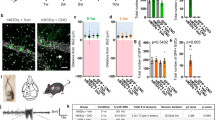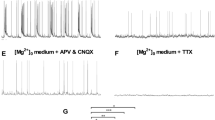Abstract
Central neurons express persistent spontaneous electrical network activity both in the developing brain in vivo as well as in dissociated cultures. This electrical activity is important for the formation of connections among neurons, and for their survival. Prolonged suppression of the spontaneous activity using the sodium channel blocker tetrodotoxin (TTX) causes the death of the cultured neurons. In the present study, we investigated molecular mechanisms that may underlie the activity-suppressed slow degeneration of cortical neurons in culture. Already after 6–7 days of exposure to TTX, neurons begin to express apoptotic vacuoles and shrunken dendrites. Eventually, neurons activate p53, caspase-3 and BAX, hallmarks of neuronal apoptosis, before they die. This death is restricted to neurons, and no parallel process is seen in glial cells that co-exist in the culture. These experiments may lead to a better understanding of slow neuronal death, akin to that found in neurodegenerative diseases of the brain.



Similar content being viewed by others
References
Arundine M, Tymianski M (2003) Molecular mechanisms of calcium dependent neurodegeneration in excitotoxicity. Cell Calcium 34:325–337
Biswas SC, Ryu E, Park C, Malagelada C, Greene LA (2005) Puma and p53 play required roles in death evoked in a cellular model of Parkinson disease. Neurochem Res 6–7:839–845
Choi DW (1988) Glutamate neurotoxicity and diseases of the nervous system. Neuron 1:623–634
Cuervo AM (2006) Autophagy in neurons: it is not all about food. Trends Mol Med 12:461–464
Dauer W, Przedborski S (2003) Parkinson’s disease: mechanisms and models. Neuron 39:889–909
Dawson TM, Dawson VL (2003) Molecular pathways of neurodegeneration in Parkinsons disease. Science 302:819–822
Festjens N, Vanden Berghe T, Vandenabeele P (2006) Necrosis, a well-orchestrated form of cell demise: signalling cascades, important mediators and concomitant immune response. Biochim Biophys Acta 1757:1371–1387
Fishbein I, Segal M (2007) Miniature synaptic currents become neurotoxic to chronically silenced neurons. Cereb Cortex 17(6):1292–1306
Golstein P, Kroemer G (2007) Cell death by necrosis: towards a molecular definition. Trends Biochem Sci 32:37–43
Hara T, Nakamura K, Matsui M, Yamamoto A, Nakahara Y, Suzuki-Migishima R, Yokoyama M, Mishima K, Saito I, Okano H, Mizushima N (2006) Suppression of basal autophagy in neural cells causes neurodegenerative disease in mice. Nature 441:885–889
Ishikawa Y, Satoh T, Enokido Y, Nishio C, Ikeuchi T, Hatanaka H (1990) Generation of reactive oxygen species release of glutamate and activation of caspases are required for oxygen induced apoptosis of embryonic hippocampall neurons in culture. Brain Res 824:71–80
Jellinger KA (2003) General aspects of neurodegeneration. J Neural Transm Suppl 65:101–144
Lang-Rollin IC, Rideout HJ, Noticewala M, Stefanis L (2003) Mechanisms of caspase-independent neuronal death: energy depletion and free radical generation. J Neurosci 23:11015–11025
Mandel RJ, Gage FH, Clevenger DG, Spratt SK, Snyder RO, Leff SE (1999) Nerve growth factor expressed in the medial septum following invivo gene delivery using recombinant adeno associated viral vector protects cholinergic neurons from fimbria fornix lesion induced degeneration. Expt Neurol 155:59–64
Mandel S, Grunblatt E, Riederer P, Gerlach M, Levites Y, Youdim MB (2003) Neuroprotective strategies in Parkinson’s disease: an update on progress. CNS drugs 17:729–762
Maulik N, Kagan VE, Tyurin VA, Das DK (1998) Redistribution of phosphatidylethanolamine and phosphatidylserine precedes reperfusion-induced apoptosis. Am J Physiol 274:H242–H248
Nair VD (2006) Activation of p53 signaling initiates apoptotic death in a cellular model of Parkinson’s disease. Apoptosis (6):955-966
Obrenovitch TP (1999) High extracellular glutamate and neuronal death in neurological disorders. Cause, contribution or consequence? Ann N Y Acad Sci 890:273–286
Olney JW (1981) Kainic acid and other excitotoxins: a comparative analysis. Adv Biochem Psychopharmacol 27:375–384
Papa M, Bundman MC, Greenberger V, Segal M (1995) Morphological analysis of dendritic spine development in primary cultures of hippocampal neurons. J Neurosci 15:1–11
Polster BM, Fiskum G (2004) Mitochondrial mechanisms of neural cell apoptosis. J Neurochem 90:1281–1289
Rao MV, Mohan PS, Peterhoff CM, Yang DS, Schmidt SD, Stavrides PH, Campbell J, Chen Y, Jiang Y, Paskevich PA, Cataldo AM, Haroutunian V, Nixon RA (2008) Marked calpastatin (CAST) depletion in Alzheimer’s disease accelerates cytoskeleton disruption and neurodegeneration: neuroprotection by CAST overexpression. J Neurosci 28(47):12241–12254
Schonfeld-Dado E, Fishbein I, Segal M (2009) Degeneration of cultured cortical neurons following prolonged inactivation: molecular mechanisms. J Neurochemistry (in press)
Yuan J, Lipinski M, Degterev A (2003) Diversity in the mechanisms of neuronal cell death. Neuron 40:401–413
Zhang LI, Poo MM (2001) Electrical activity and development of neural circuits. Nat Neurosci 4(Suppl):1207–1214
Acknowledgments
We thank V. Greenberger for the preparation of the cultures.
Author information
Authors and Affiliations
Corresponding author
Rights and permissions
About this article
Cite this article
Schonfeld-Dado, E., Segal, M. Activity-dependent survival of neurons in culture: a model of slow neurodegeneration. J Neural Transm 116, 1363–1369 (2009). https://doi.org/10.1007/s00702-009-0256-3
Received:
Accepted:
Published:
Issue Date:
DOI: https://doi.org/10.1007/s00702-009-0256-3




